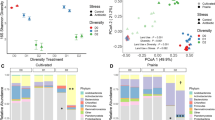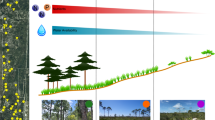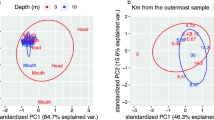Abstract
A fundamental issue in microbial and general ecology is the question to what extent environmental conditions dictate the structure of communities and the linkages with functional properties of ecosystems (that is, ecosystem function). We approached this question by taking advantage of environmental gradients established in soil and sediments of small stream corridors in a recently created, early successional catchment. Specifically, we determined spatial and temporal patterns of bacterial community structure and their linkages with potential microbial enzyme activities along the hydrological flow paths of the catchment. Soil and sediments were sampled in a total of 15 sites on four occasions spread throughout a year. Denaturing gradient gel electrophoresis (DGGE) was used to characterize bacterial communities, and substrate analogs linked to fluorescent molecules served to track 10 different enzymes as specific measures of ecosystem function. Potential enzyme activities varied little among sites, despite contrasting environmental conditions, especially in terms of water availability. Temporal changes, in contrast, were pronounced and remarkably variable among the enzymes tested. This suggests much greater importance of temporal dynamics than spatial heterogeneity in affecting specific ecosystem functions. Most strikingly, bacterial community structure revealed neither temporal nor spatial patterns. The resulting disconnect between bacterial community structure and potential enzyme activities indicates high functional redundancy within microbial communities even in the physically and biologically simplified stream corridors of early successional landscapes.
Similar content being viewed by others
Log in or create a free account to read this content
Gain free access to this article, as well as selected content from this journal and more on nature.com
or
References
Allison SD, Martiny JBH . (2008). Resistance, resilience, and redundancy in microbial communities. Proc Natl Acad Sci USA 105: 11512–11519.
Artigas J, Romaní AM, Gaudes A, Muñoz I, Sabater S . (2009). Organic matter availability structures microbial biomass and activity in a Mediterranean stream. Freshwat Biol 54: 2025–2036.
Bell T, Newman JA, Silverman BW, Turner SL, Lilley AK . (2005). The contribution of species richness and composition to bacterial services. Nature 436: 1157–1160.
Bell T, Gessner MO, Griffiths RI, McLaren JR, Morin PJ, van der Heijden M et al. (2009). Microbial biodiversity and ecosystem functioning under controlled conditions and in the wild. In: Naeem S, Bunker DE, Hector A, Loreau M, Perrings C (eds). Biodiversity, Ecosystem Functioning, and Human Wellbeing: An Ecological and Economic Perspective. Oxford University Press: Oxford, pp 121–133.
Brankatschk R, Töwe S, Kleineidam K, Schloter M, Zeyer J . (2011). Abundances and potential activities of nitrogen cycling microbial communities along a chronosequence of a glacier forefield. ISME J 5: 1025–1037.
Buesing N, Gessner MO . (2002). Comparison of detachment procedures for direct counts of bacteria associated with sediment particles plant litter and epiphytic biofilms. Aquat Microb Ecol 27: 29–36.
Burke C, Steinberg P, Rusch D, Kjelleberg S, Thomas T . (2011). Bacterial community assembly based on functional genes rather than species. Proc Natl Acad Sci USA 108: 14288–14293.
Cardinale BJ, Matulich KL, Hooper DU, Byrnes JE, Duffy E, Gamfeldt L et al. (2011). The functional role of producer diversity in ecosystems. Am J Bot 98: 572–592.
Casamayor EO, Schäfer H, Bañeras L, Pedrós-Alió C, Muyzer G . (2000). Identification of and spatio-temporal differences between microbial assemblages from two neighboring sulfurous lakes: comparison by microscopy and denaturing gradient gel electrophoresis. Appl Environ Microbiol 66: 499–508.
Comte J, del Giorgio PA . (2009). Links between resources, C metabolism and the major components of bacterioplankton community structure across a range of freshwater ecosystems. Environ Microbiol 11: 1704–1716.
Davidson EA, Janssens IA . (2006). Temperature sensitivity of soil carbon decomposition and feedbacks to climate change. Nature 440: 165–173.
Docherty KM, Young KC, Maurice PA, Bridgham SD . (2006). Dissolved organic matter concentration and quality influences upon structure and function of freshwater microbial communities. Microb Ecol 52: 378–388.
Egli T . (1995). The ecological and physiological significance of the growth of heterotrophic microorganisms with mixtures of substrates. Adv Microb Ecol 14: 305–386.
Findlay S, Sinsabaugh RL . (2006). Large-scale variation in subsurface stream biofilms: a cross-regional comparison of metabolic function and community similarity. Microb Ecol 52: 491–500.
Findlay SEG, Sinsabaugh RL, Sobczak WV, Hoostal M . (2003). Metabolic and structural response of hyporheic microbial communities to variations in supply of dissolved organic matter. Limnol Oceanogr 48: 1608–1617.
Flury S, Gessner MO . (2011). Experimentally simulated global warming and nitrogen enrichment effects on microbial litter decomposers in a marsh. Appl Environ Microbiol 77: 803–809.
Gerull L, Frossard A, Gessner MO, Mutz M . (2011). Variability of heterotrophic metabolism in small stream corridors of an early successional watershed. J Geophys Res Biogeosci 116: G02012.
Gerwin W, Schaaf W, Biemelt D, Fischer A, Winter S, Hüttl RF . (2009). The artificial catchment “Chicken Creek” (Lusatia, Germany) - a landscape laboratory for interdisciplinary studies of initial ecosystem development. Ecol Eng 35: 1786–1796.
Gessner MO, Swan CM, Dang CK, McKie BG, Bardgett RD, Wall DH et al. (2010). Diversity meets decomposition. Trends Ecol Evol 25: 372–380.
Griffiths BS, Ritz K, Bardgett RD, Cook R, Christensen S, Ekelund F et al. (2000). Ecosystem response of pasture soil communities to fumigation-induced microbial diversity reductions: an examination of the biodiversity-ecosystem function relationship. Oikos 90: 279–294.
Guenet B, Danger M, Abbadie L, Lacroix G . (2010). Priming effect: bridging the gap between terrestrial and aquatic ecology. Ecology 91: 2850–2861.
Hammes FA, Egli T . (2005). New method for assimilable organic carbon determination using flow-cytometric enumeration and a natural microbial consortium as inoculum. Environ Sci Technol 39: 3289–3294.
Jones SE, Lock MA . (1993). Seasonal determination of extracellular hyrolytic activities in heterotrophic and mixed heterotrophic/autotrophic biofilms from two contrasting rivers. Hydrobiologia 257: 1–16.
Kritzberg ES, Langenheder S, Lindström ES . (2006). Influence of dissolved organic matter source on lake bacterioplankton structure and function - implications for seasonal dynamics of community composition. FEMS Microbiol Ecol 56: 406–417.
Langenheder S, Lindström ES, Tranvik LJ . (2005). Weak coupling between community composition and functioning of aquatic bacteria. Limnol Oceanogr 50: 957–967.
Langenheder S, Lindström ES, Tranvik LJ . (2006). Structure and function of bacterial communities emerging from different sources under identical conditions. Appl Environ Microbiol 72: 212–220.
Langenheder S, Bulling MT, Solan M, Prosser JI . (2010). Bacterial biodiversity-ecosystem functioning relations are modified by environmental complexity. PLoS ONE 5: 1–9.
Larned ST, Datry T, Arscott DB, Tockner K . (2010). Emerging concepts in temporary-river ecology. Freshwat Biol 55: 717–738.
Lennon JT, Jones SE . (2011). Microbial seed banks: the ecological and evolutionary implications of dormancy. Nat Rev Microbiol 9: 119–130.
Lindström ES . (2000). Bacterioplankton community composition in five lakes differing in trophic status and humic content. Microb Ecol 40: 104–113.
Milner AM, Fastie CL, Chapin III FS, Engstrom DR, Sharman LC . (2007). Interactions and linkages among ecosystems during landscape evolution. BioScience 57: 237–247.
Östman Ö, Drakare S, Kritzberg ES, Langenheder S, Logue JB, Lindström ES . (2010). Regional invariance among microbial communities. Ecol Lett 13: 118–127.
Peter H, Beier S, Bertilsson S, Lindström ES, Langenheder S, Tranvik LJ . (2011). Function-specific response to depletion of microbial diversity. ISME J 5: 351–361.
Pohlon E, Marxsen J, Küsel K . (2010). Pioneering bacterial and algal communities and potential extracellular enzyme activities of stream biofilms. FEMS Microbiol Ecol 71: 364–373.
Rier ST, Kuehn KA, Francoeur SN . (2007). Algal regulation of extracellular enzyme activity in stream microbial communities associated with inert substrata and detritus. J N Am Benthol Soc 26: 439–449.
Romaní AM, Marxsen J . (2002). Extracellular enzymatic activities in epilithic biofilms of the Breitenbach: microhabitat differences. Arch Hydrobiol 155: 541–555.
Romaní AM, Vazquez E, Butturini A . (2006a). Microbial availability and size fractionation of dissolved organic carbon after drought in an intermittent stream: biogeochemical link across the stream-riparian interface. Microb Ecol 52: 501–512.
Romaní AM, Fischer H, Mille-Lindblom C, Tranvik LJ . (2006b). Interactions of bacteria and fungi on decomposing litter: differential extracellular enzyme activities. Ecology 87: 2559–2569.
Rulik M, Spácil R . (2004). Extracellular enzyme activity within hyporheic sediments of a small lowland stream. Soil Biol Biochem 36: 1653–1662.
Schneider T, Riedel K . (2010). Environmental proteomics: analysis of structure and function of microbial communities. Proteomics 10: 785–798.
Sinsabaugh RL, Follstad Shah JJ . (2010). Integrating resource utilization and temperature in metabolic scaling of riverine bacterial production. Ecology 91: 1455–1465.
Sinsabaugh RL, Antibus RK, Linkins AE . (1991). An enzymic approach to the analysis of microbial activity during plant litter decomposition. Agric Ecosys Environ 34: 43–54.
Sinsabaugh RL, Lauber CL, Weintraub MN, Ahmed B, Allison SD, Crenshaw C et al. (2008). Stoichiometry of soil enzyme activity at global scale. Ecol Lett 11: 1252–1264.
Sloan WT, Lunn M, Woodcock S, Head IM, Nee S, Curtis TP . (2006). Quantifying the roles of immigration and chance in shaping prokaryote community structure. Environ Microbiol 8: 732–740.
R Development Core Team (2011). R: a language and environment for statistical computing. Vienna, Austria, (http://www.R-project.org).
Urban MC, De Meester L . (2009). Community monopolization: local adaptation enhances priority effects in an evolving metacommunity. Proc Roy Soc B 276: 4129–4138.
Van Der Gucht K, Cottenie K, Muylaert K, Vloemans N, Cousin S, Declerck S et al. (2007). The power of species sorting: local factors drive bacterial community composition over a wide range of spatial scales. Proc Natl Acad Sci USA 104: 20404–20409.
Vitousek PM . (2004). Nutrient Cycling and Limitation: Hawai’i as a Model System. Princeton University Press, Princeton, NJ.
Wertz S, Degrange V, Prosser JI, Poly F, Commeaux C, Freitag T et al. (2006). Maintenance of soil functioning following erosion of microbial diversity. Environ Microbiol 8: 2162–2169.
Wilczek S, Fischer H, Pusch MT . (2005). Regulation and seasonal dynamics of extracellular enzyme activities in the sediments of a large lowland river. Microb Ecol 50: 253–267.
Winemiller KO, Flecker AS, Hoeinghaus DJ . (2010). Patch dynamics and environmental heterogeneity in lotic ecosystems. J N Am Benthol Soc 29: 84–99.
Woodcock S, Curtis TP, Head IM, Lunn M, Sloan WT . (2006). Taxa-area relationships for microbes: the unsampled and the unseen. Ecol Lett 9: 805–812.
Ylla I, Borrego C, Romaní AM, Sabater S . (2009). Availability of glucose and light modulates the structure and function of a microbial biofilm: research article. FEMS Microbiol Ecol 69: 27–42.
Zeglin LH, Sinsabaugh RL, Barrett JE, Gooseff MN, Takacs-Vesbach CD . (2009). Landscape distribution of microbial activity in the McMurdo dry valleys: linked biotic processes, hydrology, and geochemistry in a cold desert ecosystem. Ecosystems 12: 562–573.
Acknowledgements
We thank Vattenfall Europe Mining AG for providing the research site; A Ling, R Ender, T Wolburg, M Weber, C Kessler, M Seidel, J Westphal, K Westphal and M Stange for field or laboratory assistance; G Lippert, U Abel, R Müller and G Franke for water chemical analyses; F Hammes and colleagues for support for the use of flow cytometry; L Rosinus at the Seminar for Statistics of ETH Zurich for statistical advice; and R Freimann for critically important comments on the manuscript. This study is a contribution to the Transregional Collaborative Research Centre 38 (SFB/TRR 38) funded by the German Research Council (DFG, Bonn) and the Brandenburg Ministry of Science, Research and Culture (MWFK, Potsdam).
Author information
Authors and Affiliations
Corresponding author
Additional information
Supplementary Information accompanies the paper on The ISME Journal website
Supplementary information
Rights and permissions
About this article
Cite this article
Frossard, A., Gerull, L., Mutz, M. et al. Disconnect of microbial structure and function: enzyme activities and bacterial communities in nascent stream corridors. ISME J 6, 680–691 (2012). https://doi.org/10.1038/ismej.2011.134
Received:
Revised:
Accepted:
Published:
Issue date:
DOI: https://doi.org/10.1038/ismej.2011.134
Keywords
This article is cited by
-
Impact of macroalgal blooms on biogeochemical processes in estuarine systems: a case study in the eastern Gulf of Finland, Baltic Sea
Journal of Soils and Sediments (2024)
-
Small rain events during drought alter sediment dissolved organic carbon leaching and respiration in intermittent stream sediments
Biogeochemistry (2022)
-
Microbial functions and soil nitrogen mineralisation processes in the soil of a cool temperate forest in northern Japan
Biogeochemistry (2021)
-
Bacterial community composition and function along spatiotemporal connectivity gradients in the Danube floodplain (Vienna, Austria)
Aquatic Sciences (2020)
-
Microbial residence time is a controlling parameter of the taxonomic composition and functional profile of microbial communities
The ISME Journal (2019)



